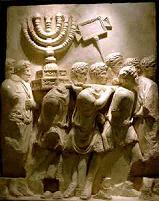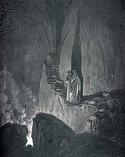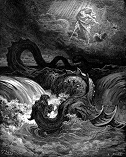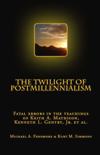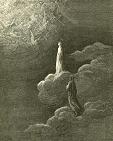The Great Red Dragon
by
Kurt M. Simmons
"And there appeared another wonder in heaven; and behold a great red dragon, having seven heads and ten horns, and seven crowns upon his heads. And his tail drew the third part of the stars of heaven, and did cast them to the earth: and the dragon stood before the woman which was about to be delivered, for to devour her child as soon as it was born."Rev. 12:3, 4
After God and Christ, Revelation's great red Dragon is, perhaps, the leading figure in the book. The Dragon is the arch enemy and adversary of Christ and the church; he tries to devour the Christ-child and persecutes the mother church. The Dragon is the animating power behind the Beast; the Beast is the Dragon's alter ego (Latin, "other I"); the Dragon acts through the Beast to make war against the saints and gather the kings of the earth together in battle against the Lamb. (Rev. 16:13, 14) In Revelation twenty, the Dragon's demise receives especial emphasis by treating it last, the final enemy to be destroyed before the resurrection of the dead. Moreover, the binding of the Dragon is central to the imagery of Revelation twenty, perhaps the most difficult and elusive chapter in the whole Bible. Whole schools of interpretation have grown up around the imagery of Revelation twenty and the binding of the Dragon; Pre-, Post-, and A-millennialism define the "millennial reign" of Christ and the saints by Dragon’s binding. Given the prominence of the Dragon in the book of Revelation, it is critical to our interpretation of the book, and chapter twenty in particular, to have a firm handle upon the identity and significance of this character. We will be well served to establish the identity of this figure from the very outset.
The War with Michael and His Angels
The majority of expositors hold that the Dragon is a fallen angel or demonic being called the Devil and Satan. Indeed, Rev. 12:7-9 would seem to indicate as much:
"And there was war in heaven: Michael and his angels fought against the dragon; and the dragon fought and his angels, and prevailed not; neither was their place found any more in heaven. And the great dragon was cast out, that old serpent, called the Devil, and Satan, which deceiveth the whole world: he was cast out into the earth, and his angels with him."
Since the text calls the Dragon "the Devil and Satan" the assumption is that a demonic or other personal being is contemplated by the text. Use of the pronouns "he" and "him" and "his" in reference to the Dragon seem to confirm this conclusion. However, this is to greatly mistake the case. Revelation is a book of prophecy; the language of the prophets is poetic and figurative, impressed with metaphors and other literary devices. Like parables, the imagery conveys basic spiritual truths through word pictures. However, whereas parables employ the familiar, mundane characters and circumstances of every day life, prophecy, especially apocalyptic prophecy, employs fantastical, preternatural characters and circumstances to convey its message. Thus, whereas Jesus' parables evoked images of day to day life in first century Palestine - images of vineyards, wine fats, agriculture and animal husbandry, Revelation employs images of heavenly apparitions, angelic beings, fabulous beasts, and plagues completely beyond the experience of mankind.
The chapter opens with a woman, clothed in the royal attire of the sun, adorned with a crown of twelve stars and the moon under her feet. She is great with child and cries out in travail, pained to be delivered. Before her is the Dragon, poised to devour her child as soon as it is born. She gives birth to a man child who is to rule the nations with a rod of iron. The man child is caught up to the throne of God and its mother flees into the wilderness from the face of the Dragon. This imagery is a clear reference to the birth of the Christ; he is the man child ordained to rule the nations with a rod of iron. (Ps. 2:7-9; cf. Rev. 2:27) The woman is the Old Testament church, Israel, the bride of God; not apostate, national Israel, ruled and corrupted by men of violence who had seized it by force (Matt. 11:12), but the faithful who groaned in travail, looking for the adoption and redemption promised from the very fall of the race itself. (Gen. 3:15) The Dragon's attempt to devour the child refers to the Slaughter of the Innocents by Herod the Great (Matt. 2:16-18), a usurper of the Davidic throne made king by the Roman Senate at the instance of Mark Anthony.[1]
The woman's flight into the wilderness refers to the scattering of the church upon the arrest and crucifixion of Christ, his ascension, and the persecution that arose over Stephen. (Matt. 26:31; Jno. 16:32; Acts 8:1, 4; cf. Zech. 13:7) However, the reference here to the ascension of Christ and the woman's flight is anticipatory; Christ does not ascend nor the woman flee until after the battle of Michael and his angels. (Rev. 12:13, 14) Michael, the Archangel, is none other than Christ; his angels are the disciples; the battle with the Dragon portrays the earthly ministry of Christ. It is characterized as being in heaven because Christ's work on earth was a spiritual battle, not a contest for a temporal throne. Christ was tempted with a temporal throne during his fast in the wilderness (Matt 4:8-10; Lk. 4:5-8), but he renounced self and submitted to the will of God, looking to the heavenly kingdom, the church. "Wherefore God also hath highly exalted him, and given him a name which is above every name; that at the name of Jesus every knee should bow, of things in heaven, and things in earth, and things under the earth; and that every tongue should confess that Jesus Christ is Lord, to the glory of God the Father." (Phil. 2:9-11) Rev. 12:11 indicates that the battle of Michael and his angels was clinched by the Son of God's death: "And they overcame him by the blood of the Lamb, and by the word of their testimony; and they loved not their lives unto death." This is echoed by Colossians, which says Christ spoiled principalities and powers in his cross; he made a show of them openly, triumphing over them in it. (Col. 2:15)
The Prince of this World
In Jno. 12:31, 32, speaking of his death, Jesus said, "Now is the judgment of this world: now shall the prince of this world be cast out. And I, if I be lifted up from the earth, will draw all men unto me." This answers to the imagery in Rev. 12:9, saying the Dragon was cast out into the earth, and his angels were cast out with him. In Jno. 13:31, Jesus gives a further indication who or what the "prince of this world" was when he says, "Hereafter I will not talk much with you: for the prince of this world cometh, and hath nothing in me." Jesus here refers to the bereavement the disciples would suffer upon his death, followed by his resurrection and ascension to the Father. The "prince" that was coming for Jesus was death itself; sin and death were the principalities and powers Christ vanquished in his cross. Sin and death reigned from Adam unto Moses. (Rom. 5:14, 17, 21; cf. Heb. 2:14) The whole creation was subjected to vanity; every people and language groaned and travailed together in pain to be delivered, waiting for the adoption and manifestation of the sons of God, the redemption of their collective body (Rom. 8:19-23; cf. Eccl. 3:18-20) when they would be "reconciled both unto God in one body by the cross." (Eph. 2:16) This is the enemy Jesus came to destroy. Death had nothing in Jesus (no power over him) because he was sinless. The sting (venom) of death is sin, and the strength of sin is the law. (I Cor. 15:56) Because he was without sin, death could not hold him and had no power over him. "God loosed the pains of death, because it was not possible that he should be holden of it." (Acts 2:24)
The battle of Michael and his angels against the Dragon and his angels was the redemptive work of Christ, beginning in his earthly ministry and consummating in his death, burial, and resurrection. By his death, Christ canceled the handwriting of ordinances against man (Col. 2:14), the debt and bond of sin; by his resurrection he vanquished death itself. Thus spoiling principalities and powers, Jesus could say "I have the keys of hell (hades) and of death...He that overcometh shall not be hurt of the second death." (Rev. 1:18; 2:11) The legal dominion of sin and death were vanquished in Christ's cross, but it remained for his disciples to receive the adoption and manifestation of the sons of God, the redemption of their collective body at the "dispensation of the fulness of times" (Eph. 1:10), the "time of reformation" (Heb. 9:10), the "regeneration" (Matt. 19:28), and "restitution of all things. " (Acts 3:21) The time of the great consummation was the close of the Mosaic age, marked by the destruction of the city and temple, when God would "cast out" the Jews, and give the kingdom to others. (Matt. 8:11, 12; cf. Gal. 4:30) However, prior to this the church had to wage spiritual battle; sin and death, acting through the children of disobedience, would persecute the church. Spiritual wickedness in high places (Eph. 6:12) in the form of kings and rulers of the Romans and Jews, would persecute the woman, seeking to retain the kingdom themselves. It is here that the great red Dragon assumes a double meaning, shifting from a symbol of sin and death to a symbol of men and governments engaged in mortal combat against Christ and the church.
The Old Serpent Called the Devil and Satan
The serpent is a familiar character in the Old Testament canon. Carrying its venom beneath its tongue, the serpent beguiled the woman in the garden. (Gen. 3:1-4) The serpent thence became a figure for sin and death, the ultimate enemy of man. But God would provide a Redeemer. Death would strike at the promised seed in the crucifixion of Christ, but Christ would crush the serpent's head in his resurrection. (Gen.3:15; cf. I Cor. 15:56) Isaiah likens Israel's struggle for salvation to a woman in travail, unable to find deliverance. God promised deliverance, saying "thy dead men shall live, together with my dead body shall they arise...In that day the Lord with his sore and great and strong sword shall punish leviathan the piercing serpent, even leviathan that crooked serpent; and he shall slay the dragon that is in the sea." (Isa. 26:17; 27:1) In its immediate context, the words of the prophet looked to the return of the captivity out of Babylon and the gathering of the Diaspora from Assyria and Egypt and the places where they had been scattered. Leviathan refers to the world civil powers that had afflicted and oppressed God’s people, but the further, Messianic application to the resurrection and Christ's victory over sin and death are unmistakable. The serpent therefore stands at once for both sin and death and the enemies and adversaries of God; because of their subjection and obedience to sin and death, the imagery of the serpent is transferred and applied also to men and nations. Assyria is a serpent; from his root springs forth a cockatrice, "a fiery flying serpent" viz., the nation of Babylon. (Isa. 14:29; 27:1, 13 cf. Jer. 51:44) Leviathan, the great serpent, is put for Pharaoh and his armies. (Ps. 74:14; 104:26) Ezekiel calls Pharaoh a "great dragon." (Ezek. 29:3, 4; 32:2-6) Bel, the dragon-god of the Chaldeans, is put for Babylon (Jer. 51:44), and so forth. So here, in Revelation, the serpent is the incarnation of sin and death in the form of the world civil powers set in opposition to God. That the Dragon has seven heads wearing seven diadems speaks to the seven Caesars who sat upon the throne of the world until the time of the consummation and kingdom of Christ; the ten horns speak to the president and provincial governors of the ten provinces of Rome. (Rev. 17:16)
The serpent is also called the devil. Our English word "devil" generally signifies a demonic being. However, the Greek term whence our English word is derived has a different meaning entirely. The Greek term translated devil is diabolos, meaning an accuser, a slanderer. It is derived from the word diabolo, to accuse or malign. For maligning God and saying that "ye shall not surely die" (Gen. 3:4) the serpent is thus called a devil. Numerous times diabolos is used of men who are slanderers and false accusers. Jesus called Judas Iscariot a "devil." (Jno. 6:70) In a similar manner, the high priests and elders of the Jews are probably in contemplation when it says that the "devil" put it into the heart of Judas to betray Christ for money. (Jno. 13:2) Paul warns that an elder's wife must not be a "diabolos," viz., "slanderer." (I Tim. 3:11) In the latter days, Paul said men would be "diaboloi" viz., "false accusers" (II Tim. 3:3; Tit. 2:3) Elders must be above reproach lest they fall into the snare of the "devil," viz., provide occasion to evil men and Jews who were maligners of the church. (I Tim. 3:7) Although the term can describe demons and unclean spirits, in all these cases diabolos refers strictly to men and governments. And this is how it is used in Revelation. “The accuser of our brethren is cast down, which accused them before our God day and night.” (Rev. 12:10) The Jews spread venomous lies against the church throughout the ancient world, seeking its destruction. For their slanders and accusations the Jews are described as the devil and his angels waging war with Christ and his disciples.
The term "Satan" is of Hebrew origin and signifies an "adversary." It first occurs in Num. 22:22 where it is used to describe the angel of the Lord who stood as an "adversary" (Heb. satan) to Balaam. It is also used of men: I Sam. 29:4 - David; I Kng. 11:14 - Hadad the Edomite; I Kng. 11:23, 25 - Rezon son of Eliadah; Ester 7:6 - Hamon; Matt. 16:23 - Peter. (Cf. Ps. 38:20; 71:13; 109:4, 6, 20, 29) The term is employed to describe the Persian monarchy and enemies of the Jews who resisted their resettlement of the land after the captivity. (Zech. 3:1, 2; cf. Dan. 10:13) It is probably to the Philistines Chronicles refers when it says Satan "stood up against Israel," provoking David to number the host. (I Chrn. 21:1; cf. II Sam. 24:1) In Revelation, Imperial Rome and the Jews are the adversaries of the church. Hence, they are portrayed as a great red Dragon whose political powers consist of seven heads and ten horns. To apply this language to a demonic being is to deprive the whole book of intelligibility.
Destruction of the Dragon
The destruction of the Dragon is described by the metaphor of being cast alive into the lake of fire where it would be "tormented day and night forever and ever." (Rev. 20:10; cf. 19:20) Individuals may be tormented, but governments by definition exist only in contemplation of law, consisting of the sum of the state's powers. The question therefore arises how a political entity like Rome can be tormented forever and ever. Isn't this proof that a personal being is contemplated by the text? We think not. The destruction of the Dragon is no more literal than the lake of fire itself; both are merely metaphors. The lake of fire is derived from Isa. 30:30-33 where it is used to describe the utter annihilation of the power and empire of Assyria:
"And the Lord shall cause his glorious voice to be heard, and shall show the lighting down of his arm, with the indignation of his anger, and with the flame of a devouring fire, with scattering, and tempest, and hailstones. For through the voice of the Lord shall the Assyrian be beaten down, which smote with a rod...For Tophet is ordained of old; yea, for the king it is prepared; he hath made it deep and large: the pile thereof is fire and much wood; the breath of the Lord, like a stream of brimstone, doth kindle it."
Tophet is the valley of Gehenna, a figure for the second death. Whilst encamped before Jerusalem to lay siege, the angel of the Lord smote the Assyrian host, killing 185,000 with a deadly plague. The bodies apparently were burned and buried in Tophet. The image of Tophet stacked with wood probably refers to the funeral pyres used to burn the corpses. However, the destruction of the Assyrian host did not spell the end of Assyria as a nation; it merely pointed to its complete defeat vis-à-vis God's people at that particular moment in history. From the Assyrians would arise the Babylonians who would later burn the city and temple and carry the nation into captivity. In Revelation, casting into the lake of fire likely refers to the civil wars that wasted the empire after the death of Nero. Josephus reports that 100,000 Romans died in the contest between Vitellius and Vespasian alone.[2] In a single, decisive battle between Otho and Vitellius, forty thousand were slain on each side;[3] “Many thousands” of soldiers were put to death by Galba for participation in a mutiny under Nymphidius.[4] This is in addition to the plagues and pestilence that ravished Rome under Nero, killing tens of thousands.[5] The torments are symbolic descriptions of the plagues and strokes with which God would afflict the nations of them that refuse to serve and obey him: "And this shall be the plague wherewith the Lord will smite all the people that have fought against Jerusalem; Their flesh shall consume away while they stand upon their feet, and their eyes shall consume away in their holes, and their tongue shall consume away in their mouth...And it shall be, that whoso will not come up of all the families of the earth unto Jerusalem to worship the King, the Lord of hosts, even upon them shall be no rain." (Zech. 14:12, 17) The torments assume they do not repent; hence they are portrayed as perpetual and everlasting. Imperial Rome no longer exists, but, where ever men and governments resist Christ and oppose his people, there Leviathan the serpent exists. Because the Dragon thus lives forever, it will be tormented forever, suffering the perpetual strokes and wrath of God when ever and where ever it raises its ugly head.
[1] Josephus, Antiquities of the Jews, XIV, xiv, 4; Wars of the Jews, I, xiv, 4.
[2] Josephus, Wars of the Jews, IV, xi, 3, 4; cf. Dio Cassius, Roman History, LXIV, xv, 2; LXIV, xix, 3.
[3] Dio Cassius, Roman History, LXIII, 10, 3; cf. Tacitus, Histories, II, xliv.
[4] Tacitus, Histories, I, v, vi; cf. I, xxxvii.
[5] Tacitus, Annals, XVI, xii; Loeb ed.
To receive Kurt Simmons’ e-mail newsletter, The Sword & The Plow, click the Subscribe link:
All rights reserved.
